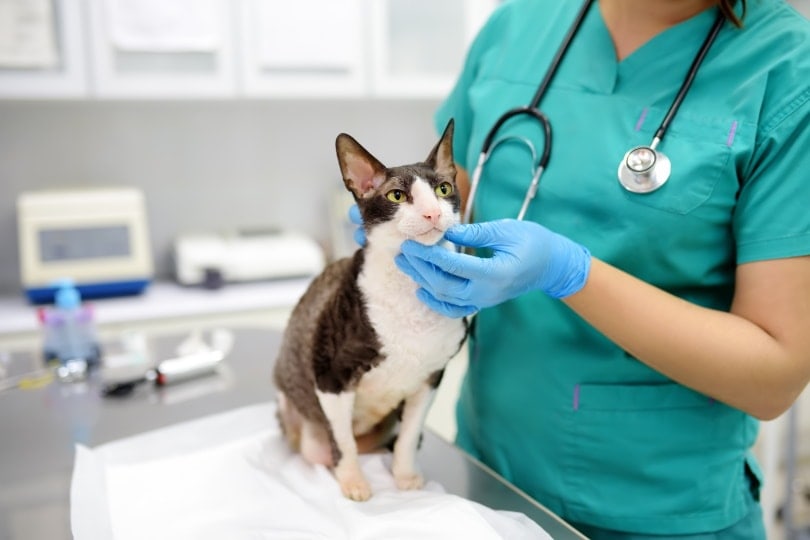How to Care for an Abused Cat: 9 Expert Tips (Vet Answer)
By Dr. Kim Podlecki, DVM (Vet)
Updated on

Humane societies, shelters, and fosters are overwhelmed by the number of cats needing adoption. Some of these cats were taken in from an outdoor feral situation, while others may have been dropped off by previous owners no longer able to care for them. Some cats may have been in abusive situations and dropped off by the previous owner. Other abused cats may have been found as a stray after it was either neglected by an abusive owner or ran away.
Oftentimes, if a shelter or humane society suspects or knows that a specific cat was abused, they will try to place that cat in a knowledgeable foster home. Being kept in a shelter would potentially be more traumatic for that cat. Caring for an abused cat takes patience, love, and time. Below are nine helpful tips for how to care for an abused cat.
The 9 Tips for Caring for an Abused Cat
1. Be Calm and Use a Quiet Voice
Without knowing exactly what your cat went through, one can assume that an abused cat was likely yelled at frequently, and may have been physically abused as well. When trying to care for an abused cat, raising your voice—either to them or in their presence—may cause them great stress. Always be mindful of the tone and volume of your voice. Try to stay calm in both your demeanor and your voice as you speak to the cat or any other animals in the house.
Also, be mindful of how you speak with people in the house around your cat. Even if you aren’t yelling directly at them, any loud or distressed voices in the house may cause your cat further trauma. Practicing patience, and remaining quiet and calm is beneficial.

2. Move Slowly
An abused cat may easily become startled by loud noises, fast movements, and unpredictable behavior. Moving quickly in the presence of your new cat may make them on edge. Domestic cats, by nature, will often run when spooked, nervous, or startled. A reactive cat may lash out at people or other animals in the house if they feel threatened. Even if the movement is meant to be playful, an abused cat may take quick, sudden movements as a threat.
Move slowly and remember to use a quiet voice until your cat trusts you and its environment more.
3. Give Your Cat a Safe Space
An abused cat needs somewhere they can sleep, hide, calm down, and feel safe. Cats are often climbers or hiders. Therefore, a safe space for an abused cat may be a cat tree in a quiet space, a hidey-bed, or even a room of their own. It is extremely important that once your cat’s safe space is set up, everyone in the house respects it. That means if there are new family members, friends, or kids over who don’t live with your cat, they must respect the safe space as well.
If your cat puts him or herself in their safe space, or you put them there to keep them calm, no one is allowed to bother them. Period. No matter how much the kids want to play with the cat, they need to respect their space. Remember, this is their safe space, and invading that area will break trust.

4. Allow Your Cat Time to Heal and Trust
Whether your cat suffered from physical abuse, verbal abuse, neglect, or all of the above, they will need time to trust again. Some cats will immediately trust their new owner, but be nervous about new surroundings. Other times, abused cats will not trust people and only trust their safe space. Whatever the reason, be patient!
People don’t heal immediately from abuse and traumatic events, and you shouldn’t expect your cat to either.
5. Don’t Make Direct Eye Contact
Some nervous and abused cats will take direct eye contact as a challenge. As people, we are taught to make eye contact when speaking to people to gain trust and show confidence. However, with animals, direct eye contact may be taken as a challenge. Don’t make direct eye contact, especially in moments when you may be frustrated with your abused cat.

6. Don’t Reach Out to the Head and Face Right Away
Approaching your cat straight on—by either walking or reaching towards them—may trigger protecting and reactive behavior. Unless your cat is in immediate danger and you need to act quickly, do not reach straight out for their head, ears, or neck. These are often areas of the body that are struck, pulled, twisted, and manipulated to cause pain in abuse cases. Your cat may be very protective of their face and head. Go slowly, and try to start by scratching the side of the face, neck, and ears. If they lean back into you and seem to like the action, slowly work around to the front of the face over time.
Also, in general, many cats do not like to be petted, especially having their bellies rubbed. While dogs will often roll over as a sign of submission to get their bellies rubbed, cats may react and strike when you try to pet them there. In general, go slow with your abused cat, and learn where he/she likes affection. You may find that your cat will never be a cuddler, and may never like to be pet. This is OK! Allow your cat to show you what they do and don’t like, and respect it.
7. Use Positive Reinforcement
Reward and encourage your cat to trust you with positive reinforcement! This may take the form of tasty treats, toys, or attention. Each cat will gravitate towards what they like best. Some cats may not want any of it at first, being completely shut down and nervous about everything. Once you give them time, they will likely respond positively to either one or multiple forms of positive reinforcement. When offering treats or a toy, always put it on the ground, or offer it with an open palm.
Every little step out of their abused shell and towards a more social and confident attitude should be rewarded.

8. Let Them Approach You
This goes hand in hand with everything we have discussed so far. As previously discussed, being loud, moving quickly or aggressively, losing patience, not respecting a safe space, and offering negative reinforcement will not be beneficial when caring for an abused cat. Allowing your cat time, space, quiet, and attention when it’s wanted will help them come out of their shell—in their own time. The key is to be patient, and let them come to you.
9. Seek Professional Help
Some abuse cases are severe. Your new cat may have previous physical, emotional, and mental wounds so severe that professional help is needed. Please contact your veterinarian to make sure that your new cat is physically healthy and comfortable. Veterinary behaviorists should also be considered in cases of severe abuse, anxiety, destruction, and/or violence. Veterinary behaviorists specialize in these cases and have gone through rigorous training and education to help.
Please beware of trainers, breeders, or others who claim to be experts in behavior. Often, these people have no medical background and may end up causing more harm than good.

Conclusion
Caring for an abused cat takes time and patience. Remember that healing takes time and space. Using a quiet voice, moving slowly, not rushing at your cat, offering them positive reinforcement, and giving them a safe space will all help them to trust you as their new owner.
Consider getting professional help from a board-certified veterinary behaviorist if your cat is a severe abuse case, or if none of these tips seem to help. Use caution using trainers, breeders, or other individuals who claim to be experts in behavior, but who otherwise have no formal training in such.
- Related Read: How to Care for a Tripod Cat: Tips & Health Advice
Featured Image Credit: Darwis Alwan, Pexels













